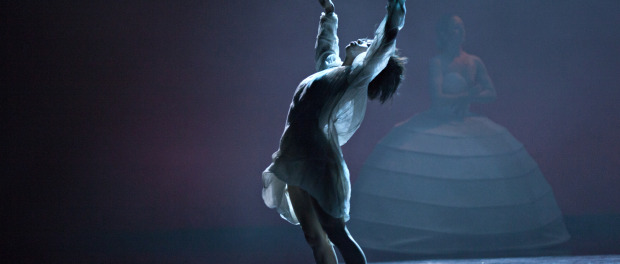Something Epic This Way Comes: Akram Khan’s iTMOi at Danse Danse
And what rough beast, its hour come round at last, slouches towards Bethlehem to be born?
Yeats’s timeless question (from his post-World War I poem “The Second Coming”) repeatedly came to mind as I watched Akram Khan’s iTMOi at Théâtre Maisonneuve Thursday night. A psychotic, fantastical, often painful tour-de-force riff on Igor Stravinsky and Sergei Diaghilev’s groundbreaking 1913 ballet, the Rite of Spring, Khan’s masterpiece takes the topic of sacrifice and uses it to explore the mind of the great Russian composer Igor Stravinsky (iTMOi=In the Mind of Igor). In Khan’s imagination, Stravinsky’s mind is a terrifying place indeed.
Khan was asked to create a piece to contribute to the centenary celebrations of the premiere of the original Ballets russes production, which took place at the Théâtre des Champs Elysées in Paris on May 29 1913. This event went down in history as one of the very, very few times where an audience rioted at a “high art” event: after about ten minutes of intense syncopation and “primitive” pagan Russian stomping, the Parisian hoi polloi started cat-calling and whomping each other over the head with their canes. The performance had to be called off. But Diaghilev’s choreographic portrayal of Stravinsky’s imagined sacrifice — a young virgin is chosen to dance herself to death in order to ensure the return of spring (something I gladly would have supported roundabout last March) — was just the first of now over 200 reinterpretations of a work that obviously speaks to each new generation of dancers and audiences.
Khan’s work is difficult to describe. It starts in darkness, with whispered, Gollum-like incantations, eventually becoming more audible: “And the Lord said take my son, take my only son, Isaac. Give him up for an offering. And Abraham said…” Khan himself seems to be whispering and eventually shouting these words, and his movements, as the lights slowly come up, can only be described as insane. Khan creates a moving portrait of the insanity brought on by being asked to perform an impossible sacrifice, and he embodies that insanity perfectly. The opening, like other segments of the work, is, simply, terrifying. At some point the incantations take on the rhythms of the famous syncopated “Danse des adolescents” of the original score. Other than this pattern, which returns once or twice more throughout the evening, almost nothing remains of the original music, except a tiny, faint hint of the opening bassoon solo at the very end of the work. The newly imagined soundtrack, composed by Nitin Sawhney, Jocelyn Pook, and Ben Frost, perfectly supports the various moods of the piece. The occasional use of near-silence (actually the sound you hear when you leave the needle on a vinyl record when the record is over) highlighted the discomfort of much of the choreography.
There is definitely a narrative for the 65-minute work, but it is difficult to discern. Suffice to say that there is a bride/queen/goddess wearing a white stiff dress, who is very still and to whom the sacrifice seems to be made; there is a “chosen one” of sorts who will be killed, but who seems later to be reborn, replacing the other woman; there is a man who tries to have himself killed in the young woman’s place — eventually he reemerges as a tortured, beaten husk of a being; there is a whirling dervish; there are nasty violent women; and there is a long-horned creature in a loin-cloth who slinks onto the stage and doesn’t leave — a wicked omen. Dance styles range from hip-hop-inflected to neoclassical to Indian/Persian to far Eastern, but nothing is derivative, everything is completely original.
I also detected hints of other Stravinsky ballets here, especially Petrushka and Les Noces, both of which contain their own elements of sacrifice: in Petrushka a “nice” guy tragically competes with a “bad” moor for a ballerina’s attention, and in Les Noces, marriage is seen as a sorrowful sacrifice on the part of the bride; both of these elements appear in Khan’s exploration of Stravinsky’s peculiar imagination.
If you really want to be spooked this Halloween, check this out. Definitely one of the most imaginative and impressive works of modern dance that I’ve seen in the last few years.
Part of the Danse Danse season at Théâtre Maisonneuve at Places des Arts October 30, 31, November 1, 8pm. Tickets start at $34.







